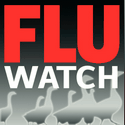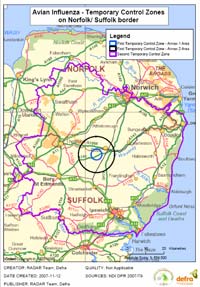Avian flu: UK special report

Latest bird flu headlines on FWi…
Bird flu update – November 2007
DEFRA has announced that the current case of avian flu (also known as bird flu), confirmed on 12 November on a turkey farm near Redgrave, Diss, on the Norfolk/Suffolk border, is the highly pathogenic H5N1 strain of the disease.
Watch the story unfold through the latest FWi avian flu headlines. Plus there’s advice on this page on what it means for farmers and the general public.
And you can also find more in-depth information and advice about avian flu in the UK and across Europe in FWi’s Avian Flu special global report or our top biosecurity tips to help keep the virus out of flocks.
What area is affected by the restriction zone?
Below is a map of the area affected, showing the 3km protection zone, 10km surveillance zone and total restricted area. Click on the map for DEFRA’s updates on the latest situation:
What do the zones mean?
- Protection zone
- Housing or isolation of poultry and other captive birds
- Movement restrictions on poultry, other captive birds, mammals, eggs, poultry meat, carcases and poultry waste except where licensed
- Biosecurity measures for people, premises and vehicles
- A ban on bird gatherings
- A ban on the release of game birds
- Housing or isolation of poultry and other captive birds
- Surveillance zone
- Similar to those in the PZ but slightly less restrictive
- The SZ must be in place for at least 30 days after the preliminary cleansing and disinfection of the infected premises
- The duration of the PZ and SZ will take account of surveillance in the area showing that there is no disease present
- Similar to those in the PZ but slightly less restrictive
- Restricted zone
- An RZ may be declared covering the whole or part of Great Britain
- Movements of poultry and eggs would be subject to licence
- The RZ is likely to reduce in size as the extent of disease spread becomes clear
- The duration of the RZ will be based on a risk assessment
- An RZ may be declared covering the whole or part of Great Britain
Source: DEFRA
What does bird flu mean for farmers and the public?
Click here for general information on the H5N1 strain of bird flu, including what the signs of the virus are, how you can catch it and what you can do to maximise biosecurity.
Further information:
- FWi biosecurity advice – best practice tips for hygiene, visitors and more
- Latest DEFRA advice on avian flu, including how to identify the clinical signs, transmission and disease control.
- Health & Safety Executive advice on working with poultry that is/ is not suspected of having avian influenza
- Department of Health advice on the risks to humans from bird flu

